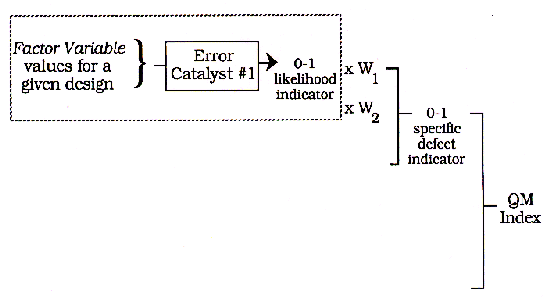

 Home page Home page |
 QM Project QM Project |  People People |  Publications Publications |  DFQM Software DFQM Software |  Mail Mail |
 Our intent is to develop a methodology which will read the design of the product (in the form of either a CAD file or some other representation) and then compute the QM-Index of the design.
Our intent is to develop a methodology which will read the design of the product (in the form of either a CAD file or some other representation) and then compute the QM-Index of the design.
 Originally, we had planned for the QM-Index to be a single number. Subsequently, we realized such a representation would not effectively display the results of the QM analysis. We have now concluded that a matrix which gives a Qm estimate for each part in the assembly in terms of each class of defects is the best solution.
Originally, we had planned for the QM-Index to be a single number. Subsequently, we realized such a representation would not effectively display the results of the QM analysis. We have now concluded that a matrix which gives a Qm estimate for each part in the assembly in terms of each class of defects is the best solution.
 Each entry in the QM-Index will be defined on the 0 to 1 scale, with a score of 0 indicating a very low quality manufacturability, and a score of 1 the converse.
Each entry in the QM-Index will be defined on the 0 to 1 scale, with a score of 0 indicating a very low quality manufacturability, and a score of 1 the converse.
 The computation scheme is designed around the error catalysts. Let each error catalyst be identified by the notation i,j,k, where k = 1,...,P are defect classes, j = 1,...,M are the specific defects in each class, and i = 1,...,N are the error catalysts effecting each specific defect. For each error catalyst let the function ø i,j,k defines its strength in a given design condition. Then S i,j,k the strength of an error catalyst, is derived as follows:
The computation scheme is designed around the error catalysts. Let each error catalyst be identified by the notation i,j,k, where k = 1,...,P are defect classes, j = 1,...,M are the specific defects in each class, and i = 1,...,N are the error catalysts effecting each specific defect. For each error catalyst let the function ø i,j,k defines its strength in a given design condition. Then S i,j,k the strength of an error catalyst, is derived as follows:
 ø i,j,k is described by a series of a hierarchically releted functions that is recorded in a functional graph which represents ø i,j,k.
ø i,j,k is described by a series of a hierarchically releted functions that is recorded in a functional graph which represents ø i,j,k. Using ø i,j,k as the basis, the structure for computing the index is:
Using ø i,j,k as the basis, the structure for computing the index is:
Quick jump to main page!
Back to The QM Research Project page!!